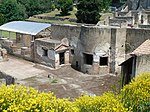Torre Annunziata
Archaeological sites in ItalyCampanian geography stubsCities and towns in CampaniaCoastal towns in CampaniaDestroyed cities ... and 9 more
Former populated places in ItalyMunicipalities of the Metropolitan City of NaplesPopulated coastal places in ItalyPopulated places established in the 1st millennium BCPre-Roman cities in ItalyRoman sites of CampaniaTorre AnnunziataTourist attractions in ItalyWorld Heritage Sites in Italy

Torre Annunziata (Italian pronunciation: [ˈtorre annunˈtsjaːta]; Neapolitan: Torr'Annunziata) is a city and commune in the Metropolitan City of Naples, region of Campania in Italy. It is located on the Gulf of Naples at the foot of Mount Vesuvius.
Excerpt from the Wikipedia article Torre Annunziata (License: CC BY-SA 3.0, Authors, Images).Torre Annunziata
Via Porto,
Geographical coordinates (GPS) Address Nearby Places Show on map
Geographical coordinates (GPS)
| Latitude | Longitude |
|---|---|
| N 40.75 ° | E 14.45 ° |
Address
Via Porto
80058 , Terravecchia
Campania, Italy
Open on Google Maps










